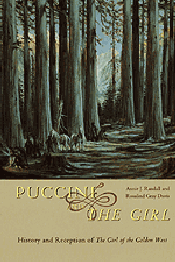The book's genesis was the inheritance from Ms. Davis's late father of a complete set of letters that passed between Giacomo Puccini and librettist Carlo Zangarini over the adaptation of David Belasco's popular western melodrama The Girl of the Golden West for the operatic stage. She and collaborator Randall have realized Professor Gray's long-frustrated intention of writing a book around these letters and, in doing so, they have expanded the topic into all aspects of the creation, rehearsal, critical response and cultural contexts of the play and opera.
Along the way they realized that a mini-biography of Zangarini would be necessary to fully understand the dynamics of the collaboration, and it is one of the most interesting parts of the book. Throughout his career, the frequently complex and turbulent dealings between Puccini and his librettists — particularly the mob scene attendant on the birth of Manon Lescaut — may have given the impression that these writers were less than ideally skilled. The truth is otherwise, supported by a complete list of Zangarini's plays, poems, libretti, song lyrics, essays and public speeches. After the opera opened in New York, Zangarini acknowledged in print that no matter how infuriating and frustrating Puccini's constant calls for cuts and improvements may have been, he was always right and that he possessed an instinctive theatrical sense.
The authors trace the lengthy development of the Italian text, made the more difficult by the three layers of English used in the west based on class and ethnic culture (and incorporated by Belasco into the play), through the employment of journalist and playwright Guelpho Civinini as libretto doctor and, most devastatingly of all, the "affaire Doria" in which Elvira Puccini drove a housemaid to suicide with scandalous public charges of being her husband's mistress. They also document the first signs of the composer's fatal cancer to the onset of frequent throat infections and irritations in the spring of 1908.
One theme that emerges strongly from Randall and Gray's in-depth coverage of the world premiere at the Metropolitan in December of 1910, the second U.S. production in Philadelphia almost immediately thereafter, and the various European premieres, is how underappreciated Fanciulla was by the critics in the face of general audience enthusiasm.
Lack of melody, lack of the many soaring arias that had graced previous Puccini operas, and the increasingly advanced harmonies the composer introduced in his new work were cited by the press as problematic. An entire chapter is devoted to the subject of "Americanness" in Fanciulla, a point touted in the advance press publicity almost to the point of hysteria, and which horrified Puccini who never claimed more than an Italian opera on an American subject; he even had placards announcing "An American Opera" removed from the Met's façade. The authors discuss the search for an indigenous American musical style that was ongoing in the early 20th century as part of the general pressure for the opera to be what the critics expected and wanted — An American Icon. (Dvorak's advice to look to American Indian and African-American music for inspiration occurred at this same time.) Without ever getting bogged down in theory, the authors place Fanciulla firmly in the Italian branch of the European imperialist appetite for the "exotic" and the "other," most readily recognized in works like Aida, Lakme, Iris and L'Africaine, etc. They speculate that critics from a nation flexing its own imperialist aspirations resented being examined as the "other" themselves, particularly given the complex racial and ethnic issues explored on both opera and play (mining camp minstrel Jake Wallace was written as a white musician performing in blackface, for example — a common bit of stage stereotyping at the time).
Randall and Gray also provide a history of the racial, ethnic and class make-up of both urban and wilderness California during the Gold Rush. They conclude with a discussion of the theme of Redemption, a rather Wagnerian operatic concept, that virtually nobody picked up on in 1910 but that was central to Puccini's vision. They look at the issue of Minnie as a prominent example of the "New Woman" who was emerging in American society at the time of the premiere, and the fact that theater audiences took her to heart but opera audiences, used to the passive, victimized woman of 19th century opera, were hesitant if not actually affronted by her independence and ability to interact with and control men. There's a brief coda looking forward to the expected glut of centennial productions in 2010, speculating on how contemporary America will deal with all these issues on stage in a still polarized nation.
In addition to the list of Zangarini's works, the last fifth of the book presents in Italian the entire Puccini-Zangarini correspondence and the text of all quotes used in the text in translation; the complete performance history of the opera at the Metropolitan up to its latest performances in 1993; an extensive discography and videography for the opera, as well as a bibliography and index.
The only aspect of the Fanciulla saga that's missing is Belasco's play script, currently difficult if not impossible to find. Searching amazon.com for the author's name and the play's title produced only a single offering that turned out on arrival at my house to be the novel Belasco made from the play rather than the script itself. The script would have been extremely valuable here as Belasco's third and fourth acts were dropped by Puccini and Zangarini in favor of the rescue drama in the mountains that we know from the opera. However, what Randall and Davis have produced is an eminently readable, ideally direct and information-packed book that's an absorbing study of a great and increasingly popular masterwork.
William Fregosi
[Editor's Note: A performance history of Fanciulla and other works at the Met may be obtained at the MetOpera Database.]
